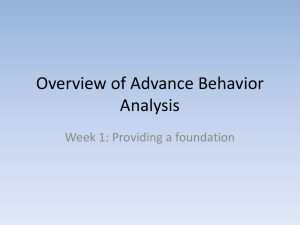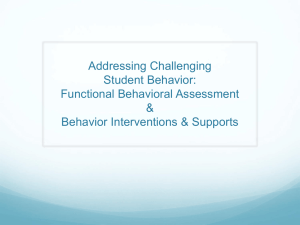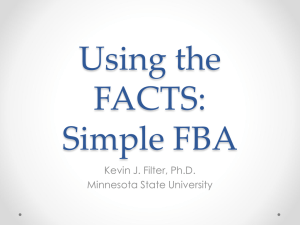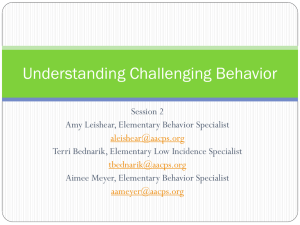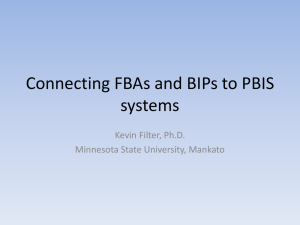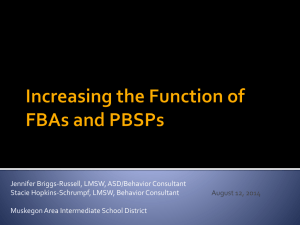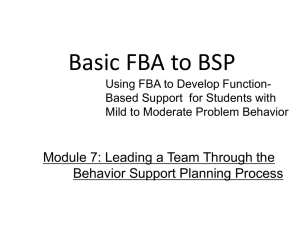Training School Personnel to Implement FBA/BIP - basicfba
advertisement
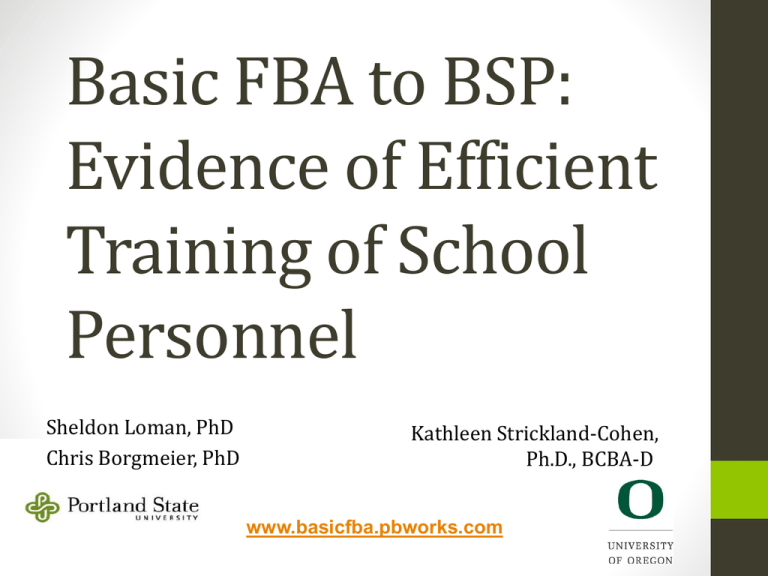
Basic FBA to BSP: Evidence of Efficient Training of School Personnel Sheldon Loman, PhD Chris Borgmeier, PhD Kathleen Strickland-Cohen, Ph.D., BCBA-D www.basicfba.pbworks.com Who’s here? o Administrators? o Teachers? o Paraprofessionals? o Behavior Specialists? o Higher Education Members? o Other related services? o Others? FBA is…. • an empirically supported practice that has been demonstrated to improve both the effectiveness & efficiency of behavioral interventions in schools • Blair, Umbreit, & Bos, 1999; Carr et al., 1999; Ingram, Lewis-Palmer, & Sugai, 2005; Lee, Sugai, & Horner, 1999; Newcomer & Lewis, 2004. Newcomer & Lewis, 2004 CHALLENGES SCHOOLS FACE TODAY ARE NOT FINDING WHAT WORKS, BUT IMPLEMENTING WHAT WORKS. FIXSEN, NAOOM, BLASE, FRIEDMAN, & WALLACE, 2005 Since 1997 FBA has not been implemented widely in schools. Not due to lack of knowledge, but to practicality of use Concern • As schools adopt Tier 2 and Tier 3 supports, the Basic Message: behavior specialists in the district are often overwhelmed with requests to conduct functional Any time assessments you feel overwhelmed the answer behavioral and building behavior support is likely to include investing in the training plans. of others. District Behavior Support Specialist Train and coach PBIS at all three tiers Support Teams building behavior support plans from Assessment information Train 1-2 people per school to conduct “basic” FBA/BSP A Proactive Approach to Behavior Support Planning • Majority of problem behaviors that teams encounter do not require comprehensive FBA-BSP (Loman & Horner, in press) • Using simplified FBA-BSP procedures that “match” the level and intensity of problem behavior • Provide FBS at the first signs of persistent problem behavior Basic FBA: Complex FBA: Behaviors and Maintaining Functions are Easily Defined and Identified Behaviors and Maintaining Functions Vary, and are not Easily Defined and/or Identified Current Issues and Needs in Your District… • Do people already know how to do FBA in your schools? • Can a district leader teach FBA/BSP procedures in a reasonable amount of time? • Are the basic FBA/BSPs developed by school personnel valid for improving student behavior? • Do our school teams understand the CRITICAL FEATURES of function-based interventions ? • Do we have materials that are practical and effective for use by district specialists? We hope you will learn to… • Identify the research-base for the use of a practical approach to training school personnel to conduct FBA/BSPs • Identify the procedures for school district behavior support specialists to use in training school personnel to conduct practical FBA/BSPs • Identify a process for creating capacity in schools to support the development and implementation of function-based interventions “Scaling Down to Scale up” • Scott, Alter, & McQuillan (2010) • In order for FBA to be applied in typical classrooms we need to simplify the practices associated with effective FBA • It is essential to use straightforward language, rationale, and examples of how FBA can be applied in the context of classroom 11 “Work Smarter NOT Harder…” By using the 4 P’s • Proactively build capacity- Train 1-2 school personnel in each school with a “flexible” role to conduct FBA/BSPs for students with mild/moderate problem behaviors • Parsimonious tools- Use simple tools and terminology that are relatable to school personnel • Practical Trainings- Provide short training sessions that teach “less more thoroughly” based on established instructional practices • Prioritized follow-up- Through use of quick in-training assessments to determine those participants that will require more follow-up coaching Responsive Instruction Student is Progressing Evaluate Response to Instruction Progress Monitoring Determine Student Skills & Expectations of Performance Need for Instructional Modification Deliver Instruction Student, Grade, & Home Plan Instruction: ü What to teach ü How to teach ü How to evaluate progress Instructional Response Format of Basic/Practical FBA Training Sessions Objectives Checks for Understanding Review Comments/ Questions Activities Tasks Key Points Available at: www.basicfba.pbworks.com Basic FBA Training Series • 4 training sessions on conducting functional behavioral assessments (FBA) for students with mild to moderate behavioral problems in schools. • The training series teaches participants to conduct interviews and observations in such a way as to precisely determine the relationship between student problem behavior and the context: – What the problem behaviors are. – When, Where, & Why a student’s problem behaviors occur. • A summary of this information will help an individual student team develop effective behavioral supports that: -prevent problem behaviors from occurring -teach alternative behaviors -& effectively respond when problem behaviors occur. Basic FBA process D.A.S.H. Define behavior in observable & measurable terms Ask about behavior by interviewing staff & student Session #1 Session #2 -specify routines where & when behaviors occur -summarize where, when, & why behaviors occur See the behavior Session #3 -observe the behavior during routines specified -observe to verify summary from interviews Hypothesize: a final summary of where, when & why behaviors occur Session #4 16 Basic FBA vs Comprehensive FBA Focus of this training series Practical FBA Comprehensive FBA For: Students with mild to moderate problem behaviors (behaviors that are NOT dangerous or occurring in many settings) Students with moderate to severe behavioral problems; may be dangerous and/or occurring in many settings What: Relatively simple and efficient process to guide behavior support planning Time-intensive process that also involves archival records review, familycentered planning, and collaboration with agencies outside of school Conducted by whom: School-based personnel (e.g., teachers, counselors, administrators) Professionals trained to conduct functional assessments with students with severe problem behaviors (e.g., school psychologists, behavior specialists) 17 Session #1: Defining & Understanding Behavior • Overview of the Practical FBA training series and introduces concepts, examples, and practice opportunities for participants to learn how to: (a) Define behavior (WHAT), (b) Identify events that predict WHEN & WHERE the specific behavior occurs (c) Identify the function of behavior (WHY), and (d) Construct functional behavioral summary statements TASK: Find someone at their site whom they may conduct a practice interview with next week. Always start with the Behavior 1- Once you have defined the behaviors (the What) 2- & know the Where & When the behaviors occur #2 (Routine & Antecedents) 3- Then want to find out WHY (the outCome of the behavior…what happens right afterwards) 2 1 3 Antecedent/Trigger: Behavior: Consequence/OutCome When _____ happens…. the student does (what)__ ..because (why) ______ 19 What is the pay-off of the problem behavior? Problem Behavior Escape/ Avoid Something Obtain/Get Something Stimulation/ Sensory Tangible/ Activity Social Adult Peer 20 Create a Hypothesis Statement for Johnny’s Behavior After interviewing Mr. Smith and conducting several observations of Johnny in the third grade classroom, the team determined that during less structured class time (free time, cooperative group art projects, etc.), Johnny tears up his paper and stomps his feet. After Johnny engages in this behavior his peers laugh at him. Routine: During __(some routine e.g.: Third _______________ grade classroom Antecedent/Trigger: “When ..” Less structured class time Behavior: “Student does..” Tears up paper & stomps feet Consequence/OutCome: “Because..” Peers laugh at him Therefore, the function of the behavior is to: 21 get/avoid Peer Attention Session #2: Investigating Behavior • Review content from the first session • Instruction, modeling, and practice opportunities in conducting FACTS interviews with staff and students (modified from Borgmeier, 2005) • Practice constructing behavioral summary statements from each interview. TASK: Complete a practice FACTS interview with a staff member at school site. Follow-up Make sure to ask follow-up questions in the right column of Antecedents & Consequences section ANTECEDENT(s): Rank Order the strongest triggers/predictors of problem behavior in the routine above. Then ask corresponding follow-up question(s) to get a detailed understanding of triggers ranked #1 & 2. Environmental Features (Rank order strongest 2) Follow Up Questions – Get as Specific as possible 1 X a. task too hard If a,b,c,d or e - describe task/demand in detail __writing sentences, paragraphs, letters, journals, etc. student cannot write because they don’t know how to read or spell fluently______________________ If f - describe purpose of correction, voice tone, volume etc. _________________________________________________ If g, h, I, j or k - describe setting/activity/content in detail ____Independent work involving writing or reading; works better in small groups if he doesn’t have to read or write____________ _________________________________________________ If l – what peers? ___ g. large group instruction ___ b. task too easy ___ h. small group work _X_ c. bored w/ task ___ i. unstructured time _X_ d. task too long ___ j. transitions ___ e. physical demand 2_X k. independent work 3_X f. correction/reprimand ___ l. with peers ___ m. Other, describe ______________________ _______________________________________ Select #1 Ranked Answers to Insert into Summary Have Teacher Rate the Statement Session #3: Observing & Summarizing Behavior • Review content from previous training sessions & practice interviews from week before • Instruction & practice opportunities (using videos) for participants to conduct ABC observations of students within routines identified as settings in which the problem behavior occurs most frequently (based upon the staff FACTS interviews). • Participants practice constructing summary statements based upon data from their observations to verify or modify summary statements derived from their FACTS interviews. TASK: Complete a practice ABC observation at school site. Videos used in training available from Sopris West: Scott, T. M., Liaupsin, C., & Nelson, C. M. (2005). Team-based Functional Assessment and Intervention Planning: A Simplified Teaming Process. Longmont, CO: Sopris West. Session #4: Function-based Behavior Support Planning • Review of concepts, skills from first three sessions • Review practice ABC observations & summarizing results • Provide opportunities for participants to practice the skills that they have learned in conducting interviews, observations, and constructing behavioral summary statements • Introduce the Competing Behavior Pathway and ideas for helping individual student support teams in designing function-based behavioral supports. Summary of Behavior - Shane Setting Event Antecedent Behavior Consequence Teacher/Staff Interview Summary Statement Academic Failure in previous class that day Difficult tasks, any word problems & most math operations Work refusal, doodling, not follow directives, yells at teacher, disruptive Avoid math task, doodling, work refusal, sent to office ABC Observation Summary Statement Negative relationship w/ teacher??? Teacher confrontation Work refusal, doodling, yells at teacher, disruptive Avoid teacher confrontation, avoid math task, to office Final Summary of Behavior (move to Behavior Plan) Negative relationship w/ teacher & previous academic failure 1. 2. Teacher confrontation Math task Work refusal, doodling, yells at teacher, disruptive Avoid math task & teacher confrontation COMPETING PATHWAYS BEHAVIOR SUPPORT PLANNING Neutralize/ eliminate setting events Add relevant & remove irrelevant triggers Teach alternative that is more efficient Add effective & & remove ineffective reinforcers Examination of Efficacy of Basic FBA Loman & Horner (2013) • To determine if staff with flexible roles in schools (e.g., counselors, administrators) can be trained to conduct FBA for students with mild to moderate behavior problems (i.e., students with recurring problems that do not involve physical aggression or violent behaviors). • To determine the efficacy and acceptability of Practical FBA methods and tools with school personnel. Methods: 3 Phases of the Study Phase 1- Practical FBA training on FBA tools & methods provided to 12 school professionals. -Pre- & Post-Tests of FBA knowledge Phase 2- 10 of the 12 Trained participants conducted an FBA according to procedures they were taught for one student within their school. -Using Practical FBA tools: interviewed, observed, and hypothesized summary of student behavior. Phase 3- Functional analyses conducted by researcher to test each participant’s hypothesis/summary statement -Experimental manipulations to determine the efficacy of the Practical FBA training . Results: Phase 2 Strongly Agree Acceptability Ratings 6 5.6 5.5 5.7 5.5 5.6 5.3 Agree 5.5 5.7 5.4 5 5 4 3 2 1 Equipped me Strongly disagree Will Use Again Suggest to Others Tools Easy to Use Teacher FACTS Student FACTS N=10 ABC Form Confident Inform Intervention Time Reasonable Overall Benefit Participant 2 Hypothesis: Access Adult Attention All 10 of the FAs confirmed the Hypothesis Statements Percentage of Intervals with Occurrence of Problem Behaviors 100% 90% 80% 70% Control Condition 60% Escape Condition 50% Attention Condition IOA 40% 30% 20% 10% 0% 1 2 3 Sessions 4 5 Contributions of Study • Use of Basic FBA v. Comprehensive FBA • Proactive, Parsimonious, Practical • School personnel can conduct “valid” FBAs for students with mild to moderate behavioral problems. • Usefulness & acceptability of training/tools • Utility of FACTS interview tool, but implications of essential direct observation validation • Ideas on how to organize personnel within a school/district to implement best practices How has Practical FBA been used? • Designed to be used by someone well-versed in FBA and behavioral principles (e.g., behavior specialist, school psychologist) to train school personnel. • School Districts have trained instructional assistants, teachers, principals, vice principals, counselors, and specialists from elementary, middle, and high schools. • Many places in the U.S. and Internationally are using Practical FBA to train school personnel to conduct FBA. From Basic FBA to Practical Training on Function-based Interventions • The most important purpose of conducting FBA is to inform the development of Behavior Support Plans that directly address the FUNCTION of student behavior FBA-BSP in Schools: How are we doing? • Growing body of research showing that FBA can be effectively conducted by typical school personnel • (Crone, Hawken, & Bergstrom, 2007; Dukes, Rosenberg, & Brady, 2007; Loman, 2010; Maag & Larson, 2004; Renshaw et al., 2008; Scott, Nelson, & Zabala, 2003) However… • Schools continue to struggle to utilize FBA information to build BSPs • (Blood & Neel, 2007; Cook et al., 2007, 2012; Scott & Kamps, 2007; Scott, Liaupsin, Nelson, & McIntyre, 2005; Van Acker, Boreson, Gable, & Potterton, 2005) In One Hour Can We Train You to Identify Effective Behavioral Interventions for Challenging Students? • Borgmeier, Loman, & Hara (under review) 41 Participants (n=361) • NorthWest PBIS Conference Attendees • Oregon (n=150 & n=51) • Washington (n=46) • Vancouver, British Columbia Training (n=22) • School District in Washington (n=20) • Portland State University Students (n=72) Critical Features of BSP RACER Replace problem behavior by teaching a socially acceptable, efficient behavior that allows student to obtain the pay-off/function Antecedent strategies to directly address triggers to prevent problems & prompt replacement behaviors based on the function of behavior Correct behaviors by quickly & effectively redirecting student to replacement behavior Extinguish behaviors by ensuring that problem behaviors do NOT pay off for the student (i.e. does not result in the function of behavior) Reinforce replacement & desired behaviors based on function/pay off for the student Pre-Test/ Post-Test Design 1 hour training + 15 min for Pre & Post-test Consequence Intervention: Reinforcing Positive Behavior Steps in Identifying Reinforcers? 1. Identify an intervention to Reinforce the Alternate Behavior 2. Identify an intervention to Reinforce the Desired Behavior Critical features of Reinforcers? a) Is reinforcer valued? (start w/ function of behavior) b) Are expectations & timeframes reasonable for the student? Yes or No? Why? Results Overall Mean Increase by 30% Percent Correct Pre v Post By Function Escape Maintained Percent Correct By Intervention Element 100% 90% 80% 70% 60% 50% 40% 30% 20% 10% 0% 89% 84% 93% 89% 86% 77% 74% 65% 61% 57% 36% 26% 83% 56% Pre Post Attention Maintained Percent Correct By Intervention Element 100% 90% 80% 70% 60% 50% 40% 30% 20% 10% 0% 88% 78% 83% 96% 85% 95% 73% 68% 61% 53% 38% 75% 52% 42% Pre Post Training Team Leaders 50 From Basic FBA to BSP Training Series (Strickland-Cohen, Loman, & Borgmeier, 2012) • Intended for use by district behavior specialists to build school capacity for providing function-based support for student with mild to moderate challenging behavior • For training school-based professionals who: • Have an understanding of basic behavioral theory • Have some training related to and experience with the FBA process • Have the role/responsibility of leading team-based behavior support planning Four 1-hour Training Sessions • Session #1: Using FBA data to identify alternative/replacement behaviors • Session #2: Identifying and selecting functionbased prevention, teaching, and consequence strategies • Session #3: Contextual fit, implementation and evaluation planning • Session #4: Leading a BSP team Screening and Assessment Responsive Instruction Student is Progressing Evaluate Response to Instruction Progress Monitoring Determine Student Skills & Expectations of Performance Need for Instructional Modification Deliver Instruction Student, Grade, & Home Plan Instruction: ü What to teach ü How to teach ü How to evaluate progress Instructional Response Assessing Knowledge of BSP Development • 10-item screening test • Basic behavioral knowledge • 50 item pretest • Assessed ability to: • List the critical features of behavior support plans • Identify missing or incorrect items on sample plan • Discriminate between Function-Based, Neutral, and Contraindicated strategies • In science, when asked to work with a partner or small group Jacob (6th grade) makes inappropriate comments, pushes materials off his desk and refuses to do his work. This is most likely on days when an altercation with a peer has occurred prior to science. Based on the data collected, the team agreed that the function of Jacob’s behavior is to avoid working with peers. Function-Based (FB)? Neutral (N)? or Contraindicated (C)? FB Teach student to appropriately request a break from working with his partner(s). 1. ____ C When problem behavior occurs, allow student to work alone. 2. ____ FB Develop a behavior contract with the student specifying that if he works successfully 3. ____ with peers for a specified part of lab time, he can spend the remainder of class time working independently. N Review class rules about respectful interactions with peers at the beginning of class. 4. ____ C When problem behavior occurs, send student to resource classroom to the complete 5. ____ activity. FB When presenting assignments on days when Jacob has had a previous peer altercation, 6. ____ provide a choice of working either individually or with a peer partner. N Provide tokens that can be exchanged for items at the school store when student 7. ____ engages in appropriate peer interactions. N Provide pull-out social skills training 2 times per week for 20 minutes. 8. ____ Delivering Instruction: HOW TO TEACH DESIRED SKILLS Principles of Instructional Design (Gilbert, 1978; Kame’enui, Carnine, Dixon, & Burns, 2007; Sidman & Stoddard, 1966; Yoon, Duncan, Lee, Scarloss, & Shapley, 2007) • • • • • Building on Background Knowledge Conspicuous Strategies Mediated Scaffolding Judicious Review Strategic Integration Responsive Instruction Student is Progressing Evaluate Response to Instruction Progress Monitoring Determine Student Skills & Expectations of Performance Need for Instructional Modification Deliver Instruction Student, Grade, & Home Plan Instruction: ü What to teach ü How to teach ü How to evaluate progress Instructional Response Format of Basic FBA to BSP Training Sessions Objectives Checks for Understanding Review Comments/ Questions Activities Tasks Key Points Objectives for Session #1: Identifying Alternative and Desired Behaviors By the end of this training session Team Leaders will be able to: 1. Label the essential components of an FBA summary statement 2. Describe the three essential characteristics of alternative behavior 3. Identify examples and non-examples of appropriate alternative behaviors given sample scenarios 4. Construct an example summary statement including antecedents, behavior, consequences, and function, providing examples of appropriate and inappropriate alternative behaviors From FBA to BSP • The most important purpose of conducting FBA is to inform the development of comprehensive Behavior Support Plans that directly address the FUNCTION of student behavior • Start with FBA results, specifically the Summary Statement After we defined the behavior (the What) & know Where & When & Why the behavior occurs… Then: We ask: Are there any events that happen outside of the routine that “SET UP” the behavior (make it more likely to occur)? Building on Background Knowledge 4 2 1 3 Setting Events Antecedents/ Triggers Behavior Consequence/ Outcome Activity #2 (page 10) What is wrong with / missing from this summary statement? Sarah often leaves her seat without permission, walks around the room and makes faces at peers. Sarah’s peers laugh or tell her to stop. This behavior is more likely if she has forgotten to take her medication before school. The function of Sarah’s behavior is to gain access to teacher attention and to escape tasks. Routine: _____________ Setting event Sarah forgets to take medication Antecedent Behavior Out of seat, faces at peers Consequence Attention from Peers Function: Adult and Peer Attn Escape from Tasks From FBA to BSP • The most important purpose of conducting FBA is to inform the development of comprehensive Behavior Support Plans that directly address the FUNCTION of student behavior • Start with FBA results, specifically the Summary Statement Developing a Competing Behavior Pathway Summary Statement: We already have this!!! Desired Behavior Natural Consequence Problem Behavior Maintaining Consequence Conspicuous Strategies Targeted Routine Setting Event Antecedent Alternative Behavior We always start with the Alternative Behavior Essential Characteristics of a Replacement Behavior • An appropriate Replacement Behavior: • Serves the same function as the problem behavior • Is easier to do and more efficient than the problem behavior • Replacement Behaviors require less physical effort & provide quicker, more reliable access to desired outcome/response than problem behavior • Is socially acceptable Identifying Appropriate Alternative Behavior • When Pam is asked to work on long-division problems in math class, she argues, refuses to work, and uses profanity in order to avoid/escape the 1. Serve same difficult task. Which is the best alternative behavior? • Move to sit by another student • Request adult attention • Request an easier task/worksheet • Ask if she can play on the computer instead • Ask for a reward for completing the task Function? Does it provide escape? 2. Is Behavior easier to do than problem behavior? 3. Is Behavior socially acceptable? Objectives for Session #2: Identifying FunctionBased Behavior Support Strategies By the end of this training session Team Leaders will be able to: 1. Describe the different types of behavior support strategies/interventions that must be included as part of the BSP 2. Discriminate between function-based and non-function-based antecedent strategies 3. Identify function-based strategies for rewarding alternative/desired behavior AND minimizing the payoff for problem behavior 4. Label missing and incorrect components, when provided with sample behavior support plans Review #1 (pg. 15) • What are the three essential characteristics of alternative behavior? 1. 2. 3. Same function as the problem behavior Easier to do than the problem behavior Socially acceptable Judicious Review REVIEW (PG. 15) • Name two problems with this competing behavior pathway. Complete writing task Success, teacher acknowledgment Routine: Language Arts Breaks from school (weekends, illness, holidays) Asked to complete Independent writing tasks Function: Disrespect and Disruption Escape academic tasks and Access peer attention Raise hand & ask for break Identifying Behavior Support Strategies Setting Event Strategies Antecedent Strategies Eliminate or Neutralize Setting Events Prevent/Modify “Triggers”/ Prompts for Alt/Des Teaching Strategies Teach Alternate / Desired Behavior Consequences Strategies Reinforce Alt/Des Behavior Team identifies a range of strategies/ interventions to address: - Prevention - Teaching - Consequences Response to Problem Behavior/ We consider the FUNCTION of the problem behavior when selecting these strategies. Selecting Antecedent Strategies: Modifying Triggers When identifying preventive antecedent strategies: - Eliminate or alter the antecedent so student will no longer need to use problem behavior The BEST antecedent MODIFICATIONS directly address: #1. The identified ANTECEDENT #2. The FUNCTION of the problem behavior Antecedent Interventions Directly address the identified antecedent • When asked to read aloud in class, Kyle makes inappropriate comments and pushes his book off his desk • Antecedent = Asked to read aloud in class • Potential options that directly address the antecedent Mediated Scaffolding • Give student passage in advance to practice pre-reading • Do not ask student to read aloud in class • Let student read 1 sentence directions that he is familiar with, instead of entire paragraphs from the text • Now, why is Function important? Antecedent interventions must address the function the problem behavior serves • When asked to read aloud in class, Kyle makes inappropriate comments and pushes his book off his desk to avoid public speaking (not related to reading difficulty; related to extreme social anxiety). • Does the Intervention Address the Function of Behavior • Give student passage in advance to practice pre-reading • Do not ask student to read aloud in class (or respond publicly) • Let student read 1 sentence directions they are familiar with, instead of entire paragraphs from the text Identifying Antecedent Strategies • When Pam is asked to work on long-division problems in math class, she argues, refuses to work, and uses profanity to avoid/escape the difficult task. Addresses: 1.Antecedent? Function? • Which is the best antecedent modifying strategy to prevent problem behavior? • Have student check in with teacher at beginning of class • Give student more time to complete the difficult tasks • Give student an easier math assignment she can be successful with • Warn student she will be sent to office for using profanity • Allow student to practice long-division on the computer Activity 1 (pg. 20) • Complete the next one on your own. • Please write ‘yes’ or ‘no’ for each option AND explain why or why not? Identifying Antecedent Strategies • When asked to read independently at his seat, Ronnie makes inappropriate noises and makes faces at peers. Based on the FBA data collected, the team agreed that the function of Ronnie’s behavior is to obtain peer attention. • Which is the best antecedent modifying strategy? • Provide student with an easier reading assignment • Remind student of school rules related to respectful behavior • Allow student to wear headphones during independent reading • Ask student to work quietly 1:1 with a ‘reading buddy’ • Have student check in with the teacher at the beginning of class Evaluating Response to Instruction • On-going Formative Evaluation • Utilize multiple response formats throughout • Written responses • Circle correct answer / Fill in the blank / short answer • Share-outs, Think-Pair-Share Responsive Instruction • Culminating activities – used to adjust teaching Student is Progressing Evaluate Response to Instruction Progress Monitoring Determine Student Skills & Expectations of Performance Need for Instructional Modification Deliver Instruction Student, Grade, & Home Plan Instruction: ü What to teach ü How to teach ü How to evaluate progress Instructional Response Routine 1st Period Writing Setting Event Parent brings to school (does not interact with peers on bus) Desired Behavior Consequence Complete writing assignment and turn in work Good grades, teacher acknowledgement Antecedent Problem Behavior Asked to finish homework or write in his journal independently Out of seat (walking around room), making noises, and talking to peers Consequence/Function Access Peer Attention Peers laugh and talk with him, and talk about it after class Alternative Behavior Ask to work with a peer Setting Events Manipulate Antecedent Arrange time for positive adult attention before writing on days when student is brought by parent Remind student before independent-work time that he may choose to work quietly with a peer Teach Behavior Alter Consequences Strategic Integration Allow student to sit with preferred peer in 1st period writing Teach student to appropriately ask to work with a peer Explicitly teach what “on-task” behavior looks like (and does not look like) in writing class Rewards Student can work with peer when asks appropriately Student can earn 5 minutes of free time with a peer, if stays on task for 90% of period for 5 consecutive days Response to Problem When student starts to get out of seat/engage in problem behavior, remind him to ask appropriately to work with a peer Objectives for Session #3: Contextual Fit, and Implementation and Evaluation Planning By the end of this training session Team Leaders will be able to: 1. Explain the meaning and importance of “contextual fit” 2. Describe the necessary components of an implementation plan 3. Describe the essential components of an evaluation plan and provide examples of appropriate short- and long-term goals and data collection procedures when provided with a sample BSP 4. Explain how data are reviewed and decisions are made based on those data during BSP review meetings What is Contextual Fit? Why is It Important? • Contextual fit refers to the extent to which support strategies “fit” with: • The skills and values of the implementers • The available resources • Administrative structure/support • In other words… How FEASIBLE are the strategies? • Strategies with good “fit” are more likely to be implemented accurately and consistently Rating Contextual Fit During Science class, Jacob often makes inappropriate comments, pushes materials off his desk and refuses to do his work. • To evaluate the effectiveness of Jacob’s BSP, the team members have suggested that his teacher: Collectatcontinuous sec partial interval data on Indicate the end of5each class period if Jacob of of each of his hadthe ( 0,occurrence/non-occurrence 1-3, or 4 or more ) instances problem problem behaviors behavior Critical Components of Behavior Support Plans • #1: Complete Competing Behavior Pathway • #2: Function-Based Preventive, Teaching, and Consequence Strategies • #3: Implementation Plan • #4: Evaluation Plan Implementation Planning: Who will do What, by When? Consider: • What specific activities will be involved? • Developing materials (ex. reinforcement system) • Designing and teaching curriculum • Data collection design • Who is responsible for implementing each part of the intervention? • When will each part of the plan be implemented? Evaluation Planning: How Will We Measure Progress?? The team identifies: - Short-term goal EVALUATION PLAN Behavioral Goal (Use specific, observable, measurable descriptions of goal) What is the short-term behavioral goal? - Long-term goal - Specific evaluation procedures - Date to meet and evaluate the effectiveness of the plan _________ Expected date What is the long-term behavioral goal? _________ Expected date Evaluation Procedures Procedures for Data Collection Data to be Collected Person Responsible Is Plan Being Implemented? Is Plan Making a Difference? Plan date for review meeting (suggested within 2 weeks) ________________ Timeline Objectives for Session #4: Leading a Team through the Behavior Support Planning Process By the end of this training session Team Leaders will be able to: 1. Describe the role of the team leader in guiding the BSP process 2. Identify the specific activities that the team leader will engage in prior to, during, and after the BSP meeting 3. Identify specific questions that the team leader will use to guide the BSP development process 4. Lead a “team” of professionals through the process of developing a sample BSP Before the Meeting Team Leader: • Read FBA results and determine if FBA contains a COMPLETE summary statement, including: • • • • Operational definition of problem behavior Routine(s) in which problem behavior occurs Antecedents (setting events & triggers) Primary consequence / Function of the problem behavior • Meeting place should provide access to a white board/markers or a projector/LCD screen (or other means of display) Identifying Strategies: Questions for the Team Setting Antecedent Teaching Consequences Event Strategies Strategies Eliminate or Neutralize Setting Events Prevent/Modify “Triggers”/ Prompts for Alt/Des How can we arrange the environment to Prevent problem behavior? How will we prompt the alternative behavior? Strategies Teach Alternate / Desired Behavior Strategies Reinforce Alt/Des Behavior How will we: How will we teach a replacement behavior? What skills can we teach to move toward the desired behavior? -Reward the Alt behavior? -Maximize payoff for approximations of desired behavior? Response to Problem Behavior How will we Minimize the Payoff for the problem behavior? Evaluating Response to Instruction • Summative Evaluation • Final activity – given scenario and FBA summary statement, lead team in BSP development • Opportunity to practice and ask questions while moving through BSP development process • Posttest data • Application in real settings WOO HOO!! Responsive Instruction Student is Progressing Evaluate Response to Instruction Progress Monitoring Determine Student Skills & Expectations of Performance Need for Instructional Modification Deliver Instruction Student, Grade, & Home Plan Instruction: ü What to teach ü How to teach ü How to evaluate progress Instructional Response Research Questions PHASE1. Is there a change in participant knowledge related to BSP development following 4 one-hour ‘From Basic FBA to BSP’ I training sessions? 2. PHASE II Are BSPs developed by participating behavior support teams viewed as a) technically adequate by external expert behavior analysts and b) contextually appropriate by the team members who implement the plans? PHASE3. Is there a functional relationship between the implementation of team-developed function-based behavior support plans and III improvement in student behavior? a. Are team-developed behavior support strategies implemented with fidelity by typical school personnel in typical settings? Study- Design by Phase • Phase 1: From “Practical FBA” to BSP training series • 13 school psychologists, counselors, special education teachers basic behavioral knowledge • Assess change in knowledge • Phase 2: Six team leaders guided behavior support teams in development of BSP for 1 student • BSPs assessed for technical adequacy (3 outside experts) • Contextual fit (school-based team members) • Phase 3: Student BSPs implemented • Direct observation data to assess: • Impact on student behavior • Fidelity of Implementation (experimental) Results Pre/Post-Test Results: Assessment of BSP Knowledge Pre Test Participant Post Test Percent Change 1 63% (A) 96% (B) +33% 2 67% (A) 84% (B) +17% 3 69% (A) 94% (B) +25% 4 65% (A) 86% (B) +21% 5 60% (A) 88% (B) +28% 6 63% (A) 90% (B) +27% 7 43% (A) 82% (B) +39% 8 61% (B) 92% (A) +31% 9 63% (B) 82% (A) +19% 10 45% (B) 80% (A) +35% 11 67% (B) 90% (A) +23% 12 61% (B) 86% (A) +25% 13 80% (B) 94% (A) +14% Mean 62% 88% +26% Intervention Baseline 100 Sebastian 75 Problem Behavior 50 Implementation Fidelity Engagement 25 0 1 2 3 4 5 6 7 8 9 10 11 12 13 14 15 16 17 18 19 20 21 22 23 24 100 25 26 27 Bailey 75 Problem Behavior 50 Implementation Fidelity 25 Engagement 0 % 10 sec intervals 1 2 3 4 5 6 7 8 9 10 11 12 13 14 15 16 17 18 19 20 21 22 23 24 100 25 26 27 Micah 75 Problem Behavior 50 Implementation Fidelity Engagement 25 0 1 2 3 4 5 6 7 8 9 10 11 12 13 14 15 16 17 18 19 20 21 22 23 24 100 25 26 27 Charlie 75 Problem Behavior 50 Implementation Fidelity 25 Engagement 0 1 2 3 4 5 6 7 8 9 10 11 12 13 14 15 16 17 18 19 20 21 22 23 24 25 26 27 100 75 Gareth Problem Behavior Implementation Fidelity 50 Engagement 25 0 1 2 3 4 5 6 7 8 9 10 11 12 13 14 Sessions 15 16 17 18 19 20 21 22 23 24 25 26 27 Basic FBA to BSP: Bethel School District • 43 Elementary/Middle participants • School Psychologists • PBIS Team Leaders & Members • Administrators • Significant range in amount of participants experience/knowledge related to FBA/BSP • Three 2-hour sessions • Session 1: FBA Interviewing & Observations • Session 2: Selecting Function-based Interventions • Session 3: Implementation & Evaluation Planning 93 Participant # BETHEL BASIC FBA to BSP PRE-POST DATA Pretest Range = 31 to 84% Posttest Range = 64 to 96% Pretest Posttest % Change 1 38% 64% 26% 2 44% 67% 23% 3 54% 71% 17% 4 50% 72% 22% 5 54% 72% 18% 6 58% 72% 14% 7 48% 73% 25% 8 52% 78% 26% 9 64% 78% 14% 10 62% 80% 18% 11 82% 80% -2% 12 31% 84% 53% 13 41% 84% 43% 14 56% 84% 28% 15 58% 84% 26% 16 58% 84% 26% 17 60% 84% 24% 18 38% 86% 48% 19 42% 86% 44% 20 48% 86% 38% 21 58% 86% 28% 22 68% 92% 24% 23 77% 92% 15% 24 80% 92% 12% 25 84% 92% 8% 26 56% 96% 40% 27 74% 96% 22% 28 80% 96% 16% 29 80% 96% 16% AVG AVG SD 58% 58% 0.15 83% 83% 0.09 25% 25% Next Steps: Sustainability • Initial District Participants • Re-take pre/posttest • Evaluate current plans • District Factors Survey • Coaching • Administrative Support • Time & Resources Basic FBA to BSP: School District in Washington • 24 participants from 5 Elementary School teams • School Psychologists • PBIS Team Leaders & Members • Administrators • Six 90-minute sessions • • • • • • Session 1: Defining Behavior Session 2: Asking/Interviewing about Behavior Session 3: Seeing/Observing Behavior Session 4: Critical Features of BSP Session 5: Contextual Fit within Critical Features Session 6: Behavior Evaluation & Implementation Planning 96 FBA Knowledge & Skills Test 97 BSP Pre & Post Test Percent Correct Pre v Post By Function New Basic FBA to BSP Training Modules • Module 1- Teaching Basic Principles** • Module 2- FBA: Practice Interviewing • Module 3- FBA: Practice Observing • Module 4- Critical Features of BSP** • Module 5- Building BSP from FBA • Module 6- Leading a Team • Module 7- Implementing/Coaching “Work Smarter NOT Harder…” By using the 4 P’s • Proactively build capacity- Train 1-2 school personnel in each school with a “flexible” role to conduct FBA/BSPs for students with mild/moderate problem behaviors • Parsimonious tools- Use simple tools and terminology that are relatable to school personnel • Practical Trainings- Provide short training sessions that teach “less more thoroughly” based on established instructional practices • Prioritized follow-up- Through use of quick in-training assessments to determine those participants that will require more follow-up coaching Thank You for Attending! • Slides and materials may be found at: • www.basicfba.pbworks.com • More information please email: • sheldon.loman@pdx.edu • strickla@uoregon.edu • cborgmei@pdx.edu
